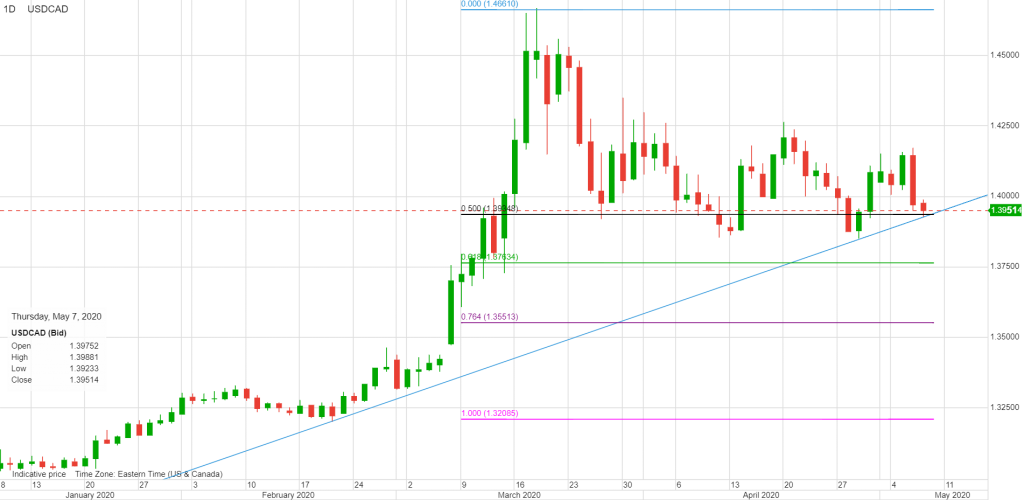
May 8, 2020
USDCAD open (6:00 am EST) 1.3941-45 Overnight Range 1.3927-1.3988
- Canada loses 1.99 million jobs (forecast 4.0 mio) Unemployment rate 13% (forecast 18%)
- US April NFP -20.5 mio (forecast -22.0 mio.) Unemployment rate 14.7% (forecast 14%)
- China/US Phase 1 trade talk progress turn risk sentiment positive
- US dollar finishing week on mixed note compared to Monday’s opening levels
Percent change in Currency value against US dollar, Monday NY open to Friday NY open (6:00 am EDT)

Source: Saxo Bank/IFXA
FX Recap and outlook:
USDCAD technical outlook: The Canadianand US employment reports were ugly, just not as ugly as expected. FX markets were underwhelmed. Nevertheless, the US dollar is modestly higher than it was before the data.
The Canadian and US employment reports were supposed to be weak due to the lockdown and restrictions implemented to combat the pandemic. The degree of weakness is mostly an academic concern, rather than and FX worry.
Traders are focusing on the post-pandemic recovery, and that focus is mildly positive.
The shift began Wednesday and sparked a commodity currency bloc rally. AUD is poised to record the largest G-10 FX gains since Monday’s NY open, followed by CAD. News that lockdown restrictions are phasing out in cities around the world and reports that China and the US are working closely to fulfil Phase 1 Trade deal obligations fueled the move.
A cynic would suggest the move is merely bad-news fatigue, as global economic normalization still has an exceptionally long way to go.
The WSJ reports that China Vice Premier Liu He, US Trade Representative Robert Lighthizer, and Treasury Secretary Steven Mnuchin “pledged to enhance economic and public-health cooperation and moved to create a favorable environment to implement January’s trade deal.”
Why is that news, and why by risk assets? The real story would be if President Trump followed through on threats to slap another round of tariffs on China because of his unhappiness with how they handled the pandemic.
The US dollar was also undermined as Fed Funds futures predicted negative US interest rates, beginning in December 2020, and continuing to January 2022.
EURUSD traded sideways in a narrow range and drifted to the bottom of its overnight range, following the release of the NFP report. EURUSD gains may be limited due to concerns around Germany and the European Union over the ECB’s quantitative easing measures. The ECB is likely to ignore the German court ruling as the President does not have much “Lagarde” for German law.
GBPUSD fully recovered its losses after the Bank of England policy meeting but retreated after the US data.. The UK is closed today, after changing their usual May Bank holiday from the 4th to the 8th, to coincide with the 75th anniversary of VE Day.
USDJPY was adrift in a 106.23-106.45 range until the employment report boosted prices to 106.68. Japan’s Finance Minister hinted at new stimulus measures, saying he would respond appropriately to the government’s wishes. Falling US Treasury yields limited topside gains.
AUDUSD and NZDUSD retreated from their recent highs in NY trading but are still higher than where they started the week.
USDCAD dropped on the back of broad US dollar selling and tested the February uptrend line at 1.3920, which held. Today’s Canadian Labour Force Survey will be quickly forgotten with prices fixated on broad US dollar and oil moves.
USDCAD technical outlook
The short-term USDCAD technicals are bullish above 1.3920 which represents the uptrend line from February. Fibonacci retracement levels on a daily chart suggests that a decisive break below 1.3920 would extend losses to 1.3763 and then 1.3550. A decisive break above 1.4180 is required to negate the downside pressure. For today, USDCAD support is at 1.3920 and 1.3860. Resistance is at 1.4010and 1.4160. Today’s Range 1.3920-1.4020
Chart: USDCAD daily

Source: Saxo Bank





